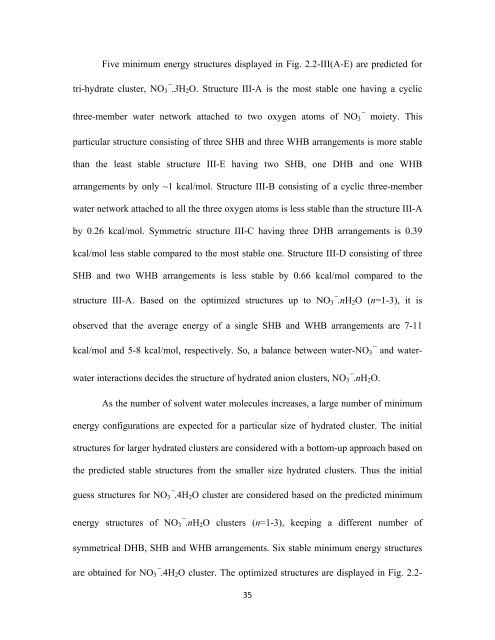CHEM01200604005 A. K. Pathak - Homi Bhabha National Institute
CHEM01200604005 A. K. Pathak - Homi Bhabha National Institute
CHEM01200604005 A. K. Pathak - Homi Bhabha National Institute
Create successful ePaper yourself
Turn your PDF publications into a flip-book with our unique Google optimized e-Paper software.
Five minimum energy structures displayed in Fig. 2.2-III(A-E) are predicted for<br />
tri-hydrate cluster, NO 3<br />
− .3H2 O. Structure III-A is the most stable one having a cyclic<br />
−<br />
three-member water network attached to two oxygen atoms of NO 3 moiety. This<br />
particular structure consisting of three SHB and three WHB arrangements is more stable<br />
than the least stable structure III-E having two SHB, one DHB and one WHB<br />
arrangements by only ~1 kcal/mol. Structure III-B consisting of a cyclic three-member<br />
water network attached to all the three oxygen atoms is less stable than the structure III-A<br />
by 0.26 kcal/mol. Symmetric structure III-C having three DHB arrangements is 0.39<br />
kcal/mol less stable compared to the most stable one. Structure III-D consisting of three<br />
SHB and two WHB arrangements is less stable by 0.66 kcal/mol compared to the<br />
−<br />
structure III-A. Based on the optimized structures up to NO 3 .nH2 O (n=1-3), it is<br />
observed that the average energy of a single SHB and WHB arrangements are 7-11<br />
−<br />
kcal/mol and 5-8 kcal/mol, respectively. So, a balance between water-NO 3 and water-<br />
−<br />
water interactions decides the structure of hydrated anion clusters, NO 3 .nH2 O.<br />
As the number of solvent water molecules increases, a large number of minimum<br />
energy configurations are expected for a particular size of hydrated cluster. The initial<br />
structures for larger hydrated clusters are considered with a bottom-up approach based on<br />
the predicted stable structures from the smaller size hydrated clusters. Thus the initial<br />
−<br />
guess structures for NO 3 .4H2 O cluster are considered based on the predicted minimum<br />
−<br />
energy structures of NO 3 .nH2 O clusters (n=1-3), keeping a different number of<br />
symmetrical DHB, SHB and WHB arrangements. Six stable minimum energy structures<br />
−<br />
are obtained for NO 3 .4H2 O cluster. The optimized structures are displayed in Fig. 2.2-<br />
35
















